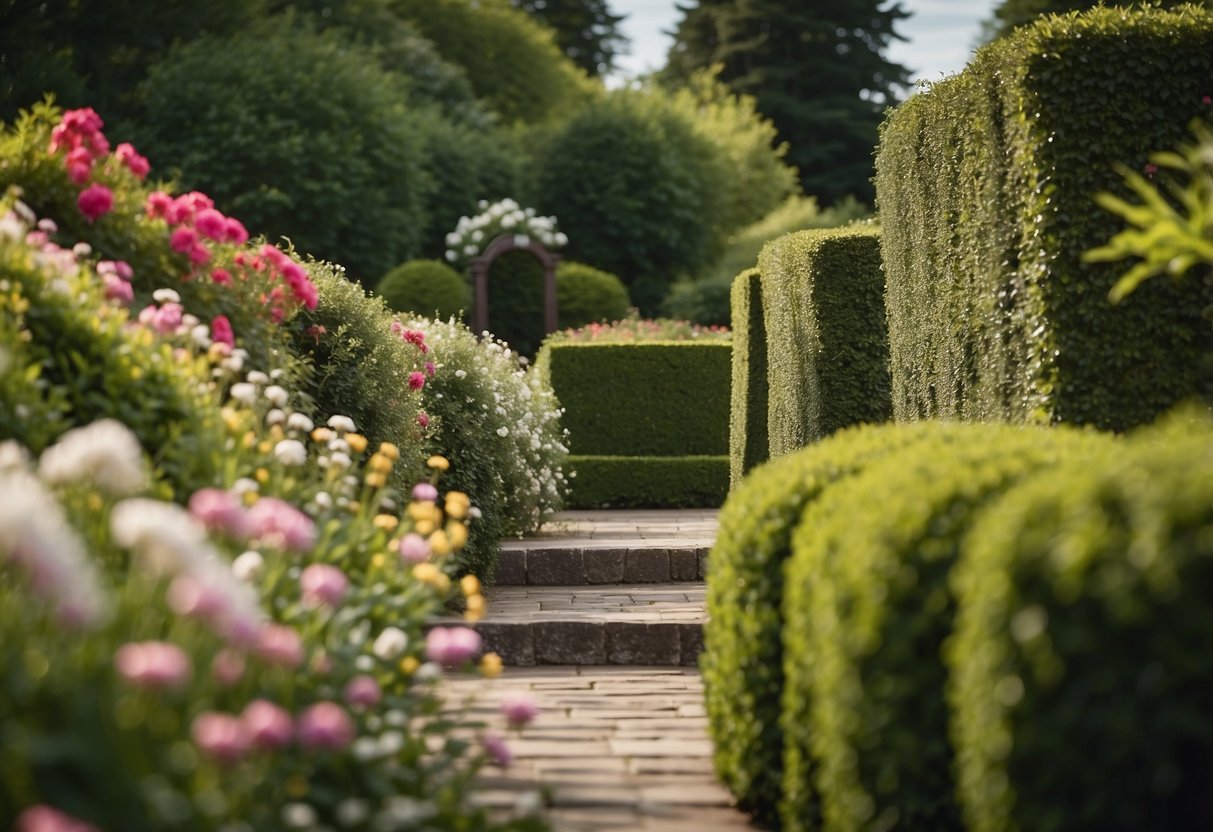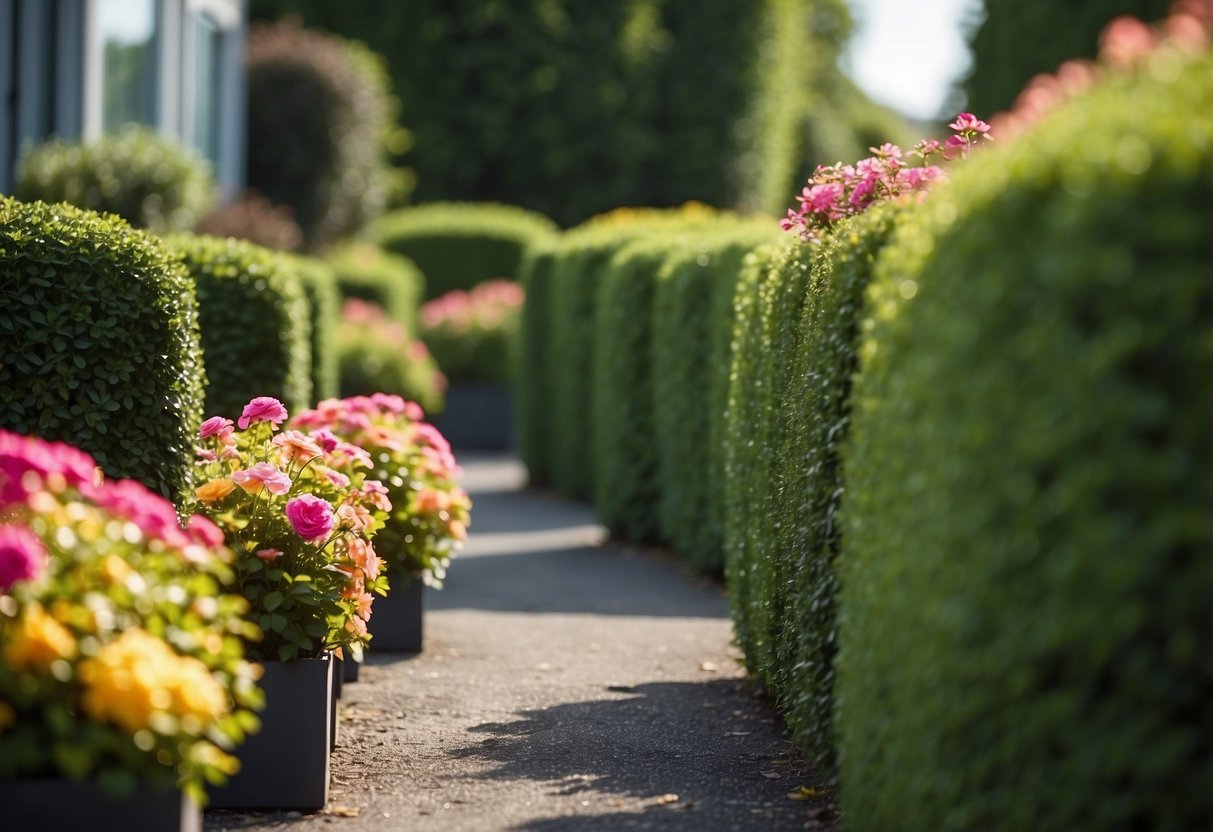Front Garden Hedge Ideas UK: Transform Your Curb Appeal
Thinking about sprucing up your front garden in the UK? Hedges can be a fantastic way to add structure and privacy to your outdoor space. They provide a green backdrop for colorful flowers and other garden features, making your yard look tidy and welcoming.

Hedges are not only visually appealing but also functional, offering benefits like noise reduction and wind protection. You’ll find that there are various types and styles to choose from, each suited to different garden sizes and personal preferences. Whether you prefer a formal, clipped look or a more natural and casual appearance, there’s a hedge that’s perfect for your front garden.
1) Boxwood Hedge (Buxus)

Boxwood (Buxus) is a popular choice for many front gardens in the UK. Its dense, evergreen foliage provides a classic look that works well in various garden styles.
You can use boxwoods to frame doorways or create low hedges that neatly edge garden beds. Their neat geometric shapes make them perfect for formal looks.
Another great idea is to plant boxwood mounds along pathways or steps. These green mounds add a stylish touch and only need occasional trimming to maintain their shape.
For more ideas on incorporating boxwood in your garden, visit Gardeningetc.
2) Yew Hedge (Taxus baccata)

A Yew Hedge (Taxus baccata) is perfect for your front garden. It has a dense columnar shape and dark green, needle-like leaves. This makes it a great choice for creating privacy.
Yew hedges do well in both full sun and shade. They don’t need a lot of water after they establish. Just trim them in the summer to keep a tidy look.
This hedge provides year-round shelter and can even produce red berry-like fruits, which are great for wildlife. For more details, visit A guide to using Taxus Baccata for a hedge.
3) Privet Hedge (Ligustrum)

If you want a classic look for your front garden, consider planting a privet hedge.
Privet hedges are easy to grow in most UK climates. They thrive in well-drained soil and can tolerate both sun and shade.
With regular pruning, your privet hedge will maintain a neat, formal appearance. Just remember to check for bird nests before you start trimming. Privet leaves can stay green throughout winter, making it a great choice for year-round beauty in your garden.
4) Beech Hedge (Fagus sylvatica)

Beech hedges are a fantastic choice for your front garden. They offer year-round interest, retaining their leaves through the winter.
Plant young beech plants about 25-45 cm apart for a dense hedge. For quicker results, use a double staggered row with 30 cm between rows.
Beech hedges can grow up to 60 cm per year. They thrive in well-drained soil and prefer sun or part shade. Plus, they are long-lived, making them a lasting addition to your garden’s landscape. For more details, check out this guide on beech hedging.
5) Holly Hedge (Ilex aquifolium)

You might want to consider a Holly hedge (Ilex aquifolium) for your front garden. Known for its dense and prickly foliage, it’s great if you want both privacy and security.
Holly is evergreen, so you’ll have greenery all year round. Female plants produce bright red berries in winter which attract birds and add to your garden’s charm.
It grows well in various soils and can be shaped easily with regular trimming. For best results, plant at least one male plant within 50 feet of females to ensure berry production.
Holly hedges can grow up to four or five meters, fitting well into both small and large spaces. They also serve as effective windbreaks and support wildlife, from birds to butterflies. If you want a tough and attractive hedge, Holly is a fantastic choice.
6) Laurel Hedge (Prunus laurocerasus)

Laurel Hedge, or Prunus laurocerasus, is a popular choice for front gardens in the UK. It has glossy, dark green leaves that provide a lush, dense screen.
Laurel Hedging can grow up to 60cm per year, making it a fast-growing option. It can be maintained at a height of 1-5 meters, depending on your preference and needs.
For more details on growing laurel, check out this complete guide.
7) Hornbeam Hedge (Carpinus betulus)

Hornbeam hedge, or Carpinus betulus, is perfect for adding privacy to your front garden. It starts off as a slim, columnar tree but grows into a lush, dense hedge.
The foliage is dark green with sharp teeth and turns yellow-orange in autumn.
To plant a hornbeam hedge, space the plants about 60 cm apart. They grow quickly and can reach up to 80 feet tall in ideal conditions. Keep your soil well-drained and free of weeds for the best growth.
Learn more about hornbeam hedges for your garden.
8) Escallonia Hedge

An Escallonia hedge offers a vibrant splash of color to your front garden. These evergreen shrubs bloom with flowers in shades of pink, red, and white, making them a cheerful addition.
You’ll find Escallonia particularly useful in coastal areas. They are tolerant of salty air and wind, ensuring they thrive where other plants might struggle.
Escallonia hedges also grow quickly, adding between 20-45 cm each year. Their dense foliage provides excellent privacy, and the glossy leaves ensure your hedge looks attractive year-round.
9) Griselinia Hedge

Griselinia is a fantastic choice for your front garden in the UK. It’s known for its vibrant, glossy green leaves that stay green all year round. This makes it perfect for adding some color to your garden, even during the winter months.
You can plant Griselinia at about 60cm apart for a dense hedge. This helps the plants grow together quickly, giving you a lush, full garden hedge in no time. For a lower hedge up to 6 feet, you might want to plant them a bit closer together.
Griselinia is also very hardy and can handle salty air and strong winds. This makes it perfect for coastal gardens or areas that get a lot of road salt during winter. Plant it in well-drained soil for the best results. Check out these growth and care tips for more information.
10) Photinia Red Robin Hedge

Photinia Red Robin is a popular choice for a front garden hedge in the UK. Its vibrant red shoots in spring add a splash of color before turning a lush green.
You can expect a dense, year-round screen with this evergreen shrub. It produces clusters of small white flowers in spring, adding extra charm.
Planting Photinia Red Robin is straightforward. Space the plants about 75cm apart for a quick-growing, dense hedge. For bigger plants, you might want to increase the spacing for better growth.
Benefits of Front Garden Hedges

Front garden hedges can offer numerous advantages. They enhance your property’s privacy and security, boost its aesthetic appeal, and support local wildlife.
Privacy and Security
Front garden hedges like cherry laurel are perfect for creating a barrier between your home and the street. These hedges grow quickly and densely, making it hard for prying eyes to see through. This natural screen not only adds privacy but also increases security by deterring trespassers.
Certain types of hedges, such as Rosa rugosa, come with thorns. These thorny hedges form a physical barrier that is difficult to cross, further protecting your property. In addition, hedges can act as windbreakers, reducing wind speed and protecting your home.
Aesthetic Appeal
Hedges can significantly improve the look of your front garden. Different types of hedges bring various colors, textures, and shapes to your garden. For example, the glossy leaves of cherry laurel add a lush, evergreen appeal, while flowering hedges like Rosa rugosa add seasonal color and charm.
Small hedges can also be used as borders to define different areas within your garden, adding structure and harmony. Evergreen hedges can maintain their form year-round, ensuring your garden looks well-kept even in winter. Incorporating hedges into your garden design can create a cohesive and pleasing visual effect.
Wildlife Support
Hedges are excellent for supporting wildlife. They provide shelter and nesting sites for various birds, protecting them from predators and the elements. For instance, Rosa rugosa is attractive to nesting birds due to its dense, thorny branches.
Hedges also attract beneficial insects like bees and butterflies, which are crucial for pollination. The berries and flowers of certain hedges can serve as a food source for wildlife, helping to sustain local ecosystems. By choosing the right hedges, you can create a thriving habitat that benefits both your garden and the local wildlife.
Choosing the Right Hedge for Your Garden

When selecting a hedge for your front garden in the UK, consider your local climate, how much maintenance you’re willing to do, and how quickly the hedge will grow and reach its desired size.
Climate Considerations
Different hedges thrive in different climates. For example, the cherry laurel is a hardy, evergreen option that can withstand harsh UK winters. On the other hand, boxwood prefers milder conditions and does well in coastal areas. Yew is another traditional choice that can tolerate both shade and frost.
Make sure to choose a hedge that matches your area’s weather patterns. A hedge that struggles in your climate will require more care and may not look its best.
Maintenance Requirements
Think about how much time you can dedicate to hedge care. Some hedges, like privet, need regular trimming to maintain their shape. This makes them great for detailed, manicured looks. Photinia can also be shaped easily and provides year-round interest with its red-tinted leaves.
If you prefer a low-maintenance option, the cherry laurel is very forgiving and requires minimal pruning. Holly is another low-maintenance choice that provides a dense, thorny barrier, which is useful for security.
Growth Rate and Size
Consider how quickly you want your hedge to grow. Boxwood grows slowly, making it ideal for hedges that don’t need frequent trimming. Privet, on the other hand, grows quickly, reaching full height in a few seasons, which is perfect if you need a fast privacy screen.
The final size of the hedge is also important. Field maple and viburnum tinus are good for medium-sized hedges, while larger options like purple beech can grow tall, providing significant privacy. Make sure the hedge will fit the available space without overwhelming your garden.
By considering these factors—climate, maintenance, and growth—you’ll choose a hedge that enhances your garden and meets your needs.







